Camden Power Station
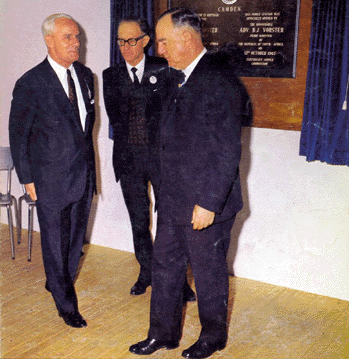
Brief History
The 18th of September, 1897 saw the commissioning of the first power station in South Africa built specifically to supply electrical energy to industry, namely the gold mines of the Witwatersrand. That station was Brakpan with an installed capacity of 3 400 kVA
In the years that followed there was a steady increase in demand until 1947 when industrial development in South Africa took off to the extent that ESCOM’s sales rose from 5 000 million units in 1947 to 24 500 million units in 1966. During this period some 12 new power stations were constructed. Of these Camden, the largest, was officially opened on 12th October 1967 by the Hon. Adv. B J Vorster, second Prime Minister of the new South African Republic.
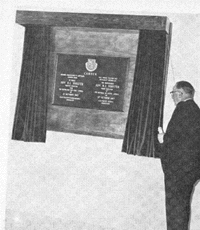
Planning and Construction
Load forecasting in the early 60’s indicated that by the end of 1966 a new power station would be required. Toward the end of 1961 the chairman of the Electricity Supply Commission, Dr Reinhart Ludwig Straszacker, decided, after an economic investigation, that a station having an ultimate capacity of 1 600 MW consisting of eight 200 MW units should be considered.
Planning started early in 1962 with the issue of an enquiry for the supply of coal. Adjudication of ensuing tenders took into account, in addition to coal costs, such items as availability and cost of water, availability and cost of rail services and cost and feasibility of transmission lines, all in relation to the geographic position of the collieries concerned.
The tender was awarded to the Trans-Natal Coal Mining Company, which had a coalfield capable of supplying a station of the size envisaged for a period of 30 years. It was situated near Camden railway station some ten miles (16 km) from Ermelo in the Eastern Transvaal (Mpumalanga). The proximity to the railway station gave the power station its name This satisfied the system operation requirement for clear unambiguous names.
Chris du Toit and Van der Walt owned the ground. The construction of a power station in this area had no effect on the surrounding community, because it was a hollow area and uncultivated ground but it did create a lot of job opportunities.
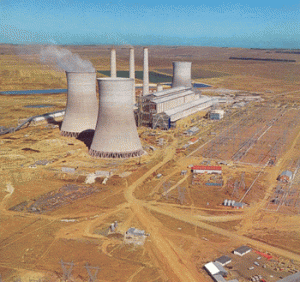
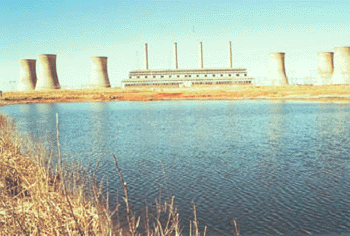
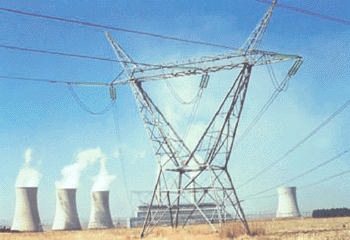
In locating power stations in the Eastern Transvaal (Mpumalanga), where abundant coal reserves were present and where the Department of Water Affairs made adequate supplies of water available, Escom was able to continue with its policy of erecting pithead power stations where power is generated cheaply. The electrical power was then transmitted over high-voltage lines to consumers.
Work began on the site in November/December 1962 and the first turbo-generator was commissioned in April 1967. The last of the eight units was commissioned in 1969.
Camden became the starting point of the national power grid, consisting of a series of 400 kV lines which today interconnect the entire country. Power flowed from Camden over a high-voltage system, which was amongst the most extensive in the world. With the low cost of generation in the pithead power stations in the Transvaal (Mpumalanga) it was more economical to supply those distant consumers in this manner than to build more coal-fired power stations in the Western Cape.
When Camden was completed it had cost R126 million and stood as another symbol of the economic strength of South Africa. Like all ESCOM stations, Camden stood as a monument to the founders of the South African power supply industry who created an enterprise in which the people of the country are the shareholders and receive dividends in the form of the benefits they derive from the use of electricity.
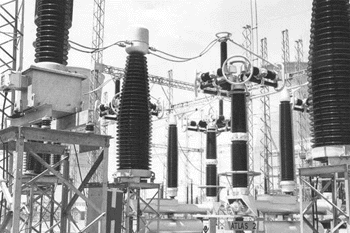
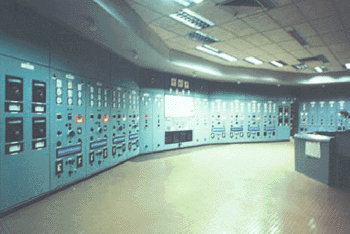
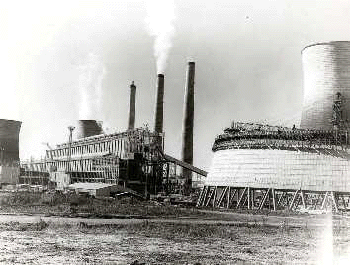
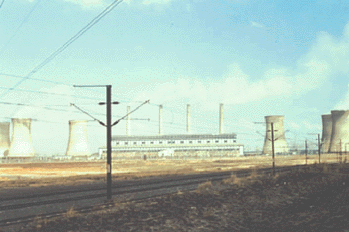
Over the years Camden power station saw many historical events in its generating life. The station won the National Fire and Rescue competition three times as well a NOSA 5 Star Grading in 1996. During its operational life, Camden saw the service of five power station managers namely Jan Zwart, Peter Collings, Mike Cook, Ben Lategan, John McInerney. Many employees who started their careers at Camden rose through the ranks and ended up as Executive Directors and power station managers. Jac Messerschmidt began as an apprentice technician and rose to be an Executive Director. Jan Zwart began as an electrician and became power station manager. Another employee Marie Schutte obtained Springbok colours in angling. There were 1 180 operational staff at the station.
Camden also saw many sad events in its history. An employee of boiler manufacturer ICAL fell through the steps and was killed instantly. An employee from Howdens fell over a rail and was killed instantly. Mr M D Mokoena burned in the coal staiths and died several hours later. There was a bomb attack on the station in 1983, and Unit transformer number 8 burnt out in 1989. During the severe drought in 1982 only one unit idled, as there was no water available to run the station.
The Official Opening
Construction proceeded satisfactorily. When the seventh meeting before the opening ceremony was held on Monday the 25th September 1967, the committee felt that provision had been made for every possible contingency. Barring anything unforeseen, the opening ceremony was expected to take place without a hitch.
Members of the planning committee went to Camden on the day before the ceremony for a last check on site. Each committee member hoped for favourable weather for the occasion. But, the signs looked ominous.
At about 4 p.m. it started raining and continued without a break into the early hours of the morning. At 3 a.m. an emergency meeting was held in the power station to consider where, if possible, the site of the ceremony could be shifted to if the rain continued. Fortunately it stopped raining and operation “mopping up” began. When a chilly dawn broke, tired workers knew that weeks of work had not been undone in a couple of hours.
So Camden was opened with the dignity befitting such a memorable occasion in the history of ESCOM.
Cooling Towers
The station has six cooling towers, each of which can cool approximately 581 900 litres per minute. These towers are 111,86 metres high above the pond sill and have a diameter of 54,25 metres at the top. The diameter of the pond sill is 85,65 metres.
Chimneys (Smoke Stacks)
Four chimneys, each 154 metres high, served the 8 boilers.
Boilers
The boiler house is 352 metres long and 65 metres high, and the turbine hall 383 metres long and 36 metres high. The overall thermal efficiency of Camden was about 32 per cent and it is interesting to compare this efficiency with that of Brakpan which was only 10 per cent. Pulverized fuel fired boilers provided the turbines with steam at a pressure and temperature of 11,03 MPa and 543° C at the boiler stop valve. At this temperature the steampipes were red hot. The coal burnt by the boilers had a calorific value of 24,65 MJ/kg (air dried value) and a surface-moisture content of 6 per cent. Under full load conditions, each boiler evaporated 226,8 kg/sec, and each is provided with a 100 per cent duty steam driven boiler feed pump, and two 50 per cent electrically driven feed pumps for stand-by and starting-up purposes.The 100 per cent duty boiler feed pump is arranged to run on steam bled from the main turbine and the exhaust steam from the steam feed pump turbine is exhausted to the de-aerator.
Turbine House
While, in general, in the other Transvaal stations built before Camden the transverse arrangement of machines in the turbine house had been adopted, they are arranged longitudinally at Camden. The reason for this is that the overall length of a turbo-generator of capacity of up to about 125 MW usually exceeds the width of a boiler of corresponding output and unless the boilers are spaced more widely than is necessary, the sets cannot be accommodated longitudinally. For units of 200 MW capacity and upwards, the width of the boilers is greater than the overall length of the sets so that the 200 MW machines can be arranged longitudinally in the turbine house without any increase in the length of the building. At the same time, an economy is effected in the width of the turbine house with a subsequent saving in building cost.
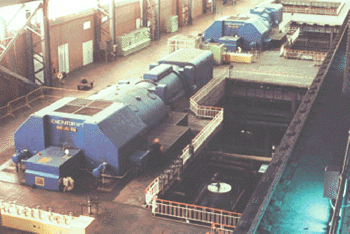
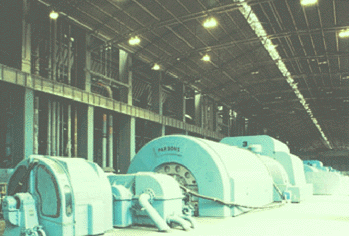
Costs
Of the total cost of R126 000 000 about 34 percent was spent on boiler plant; 25 per cent on turbo-generator plant and foundations, and the rest on civil works, electrical plant, property, pumping stations and feed mains, and the like. Of the total power station costs, nearly 80 per cent was spent locally.
Water Consumption
At maximum capacity, the power station required about 109 megalitres of water per day of which the initial supply was obtained from the Jericho Dam on the Mpama River 43 km away and additional supplies, when required, from dams on the Ngwempisi and Usutu Rivers. Of this 109 megalitres 82 megalitres, went to the cooling system where about two-thirds of it was evaporated. The remaining one-third was purged in the cooling tower ponds. Some of the purged water was used for pumping the ash from the boilers. The remaining 27 megalitres of river water was clarified, 50 per cent of it being used for consumption on the property and in the station, and the remaining 50 per cent further purified to distilled-water quality for boiler make up requirements. Camden consumed about 40 000 megalitres of water annually. However, intensive research was undertaken into the treatment of water with a view to reducing the quantity used in such a power station. Escom succeeded in reducing the quantity required by approximately 20 per cent.
Coal Supply
Coal was supplied from the colliery to the station by means of overland conveyors, which moved at the rate of 152 metres per minute and could convey approximately 726 metric tons per conveyor per hour. To avoid any interruption to the coal supplies, the Trans-Natal Coal Mining Company was asked to sink three shafts, any two of which could supply the station’s full requirements. These three shafts are known as the East, West and South shafts. Coal from the West and East shafts was transported to the South shaft by means of a conveyor belt and then to the power station. Camden consumed 5.5. million metric tons of coal annually
Residential Property
Power stations operate 24 hour per day and the men working the different shifts must be readily available to take over from the men going off duty, or to replace shift operators, which, for some or other reason, are unable to go on duty. Similarly, maintenance staff must be able to get to the power station in the shortest possible time in the event of a breakdown to restore essential plant as quickly as possible.
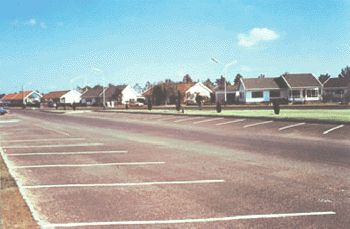
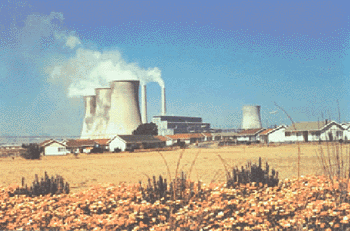
When laying out a power station such as Camden, special attention was paid to the siting of the residential property with a view to the above considerations, enabling men on call to get to their posts within minutes.
There were 356 permanent houses built in the township to house all administration, operating and maintenance personnel. Speed of erection, coupled with heaving ground conditions, led to the adoption of several types of industrialised houses being utilised. These consist of concrete block houses on pile foundations, timber sectional houses, asbestos cement polyurethane filled and gypsum lined houses.
An interdenominational hall was built and was utilised by all church groups.
The sports facilities included four tennis courts, a bowling green, swimming bath, shooting range, rugby, hockey, soccer and cricket fields and jukskei. The necessary clubhouses and changerooms were also provided.
A recreation centre comprising a hall, dining room, library, shop, bar and billard room was completed at the end of 1973.
Several parks, situated throughout the residential property, provided playgrounds for some 500 children at Camden. Schooling was provided in Ermelo for these children, with a regular bus service operating between Camden and Ermelo.
Due to an unforeseen downturn in the South African economy and consequent negative growth in the electricity demand, the decision was taken during 1989 to mothball Camden. The task fell to the following power station managers to manage the mothballing period: Henry Daneel, Johann van der Walt, Gert Clitz and Rob Worrall. The mothballing had a major effect on the community. Mines closed down, the Ermelo infrastructure suffered, and many skills and much knowledge were lost. The water plant, sewage, kitchen and compound are still intact. The property has been sold to the South African National Defence Force (SANDF) and the HV Yard has been handed over to the Transmission Group. There are still 114 employees left at Camden. The de-mothballing and re-commissioning of the station still hangs in the balance. At the time of writing, the planned comeback is schedule
TECHNICAL DATA
General Information
| Total station electrical capacity (8 sets) |
1 600 MW |
| Total boiler capacity (8 boilers) |
1 814,4 kg/sec |
| Total circulating water capacity (10 pumps) |
73,242 m3/sec |
| Station efficiency | ± 32,0% |
| Date work commenced | December 1962 |
| Date final unit commissioned | September 1969 |
| Max. Total coal consumption | 17 440 metric tons/day |
| Water consumption | 109,1 Ml/day |
|
Description of Plant
Turbine House
|
|
| Turbines | 2 cylider reaction type |
| Generators | 200 MW rating |
| Manufacturer of turbo-generators | C A Parsons |
| Steam conditions at turbine stop valve | 10,432 MPa, 538oC |
| Vacuum | 6,77 kPa |
| Speed of generators | 3 000 r.p.m. |
| Generator cooling | Hydrogen at 310 kPa |
| Generator Voltage | 16 500 volts |
| Circulating water flow | 7 274 1/sec |
| Turbine house cranes (2) | Large hoist 90 700 kg Small hoist 22 680 kg |
| Dimensions of turbine house | Length 383 m Height 36m |
|
Boiler House
|
|
| Boilers (8) single drum, radiant furnace | Pulverised fuel furnace |
| Continuous rating | 226,8 kg/sec |
| Boiler Manufecturers | International Combustion (Africa) Limited (ICAL) |
| Outlet Pressure | 11,032 MPa |
| Outlet temperature | 543oC |
| Coal consumption at full load | 90 700 kg/h |
| Calorific value of coal | 24,65 MJ/kg (air dried value) |
| Combustion Control | Automatic |
| Dimensions of boiler house | Length 352 m Height 65 m |
| Number of chimneys | 4 |
| Height of chimneys | 154 m |
|
Coal Plant
|
|
| Coal sources | Usutu South, West and East mines |
| Main conveyor from South Mine | 2 Belts, 0,8 km long |
| Conveyor from West to South Mine | 1 belt 4,59 km long |
| Conveyor from East to South Mine | 1 belt 2,12 km long |
| Number of station coal straiths | 4 |
| Capacity of 4 straiths | 72 600 metric tons |
|
Cooling Towers
|
|
| Cooling tower type | Asbestos cement packed, natural draught, hyperbolic, film type |
| Number of towers | 6 |
| Capacity | ± 581 900 1/min |
| Height above sill | 111,86 m |
| Diameter of top | 54,25 m |
| Diameter of throat | 49,99 m |
| Diameter of sill | 85,65 m |
| Temperature drop | 8,3oC |
|
Water
|
|
| Main source | Jericho Dam |
| Dam capacity | Jericho – 31 000 000 m3 |
| Pipelines – Jericho to Camden | 39 km |
| Main pipeline capacity | 81.83 Ml/day/pipe |
| Station consumption |
109,1 Ml/day |
Bibliography
Camden Power Station Brochure
ESCOM News
Megawatt Magazines
Electricity Supply Commission Annual Reports
Newspaper Cuttings Eskom Archives
ESCOM News
Megawatt Magazines
Electricity Supply Commission Annual Reports
Newspaper Cuttings Eskom Archives
Interviews
Bets de Beer – Communication Practitioner Simunye Power Stations
Various retired employees at Camden Power Station
Various retired employees at Camden Power Station
